Digital identity: A modern way to establish identity

Establishing identity nowadays has taken on a new form – digital identity. This encompasses collecting information and attributes uniquely distinguishing an individual within the digital realm.
Digital identification, compared to its traditional counterpart, can be more complex as it looks over a person’s online behavior as an alternative to their physical presence.
With more countries having national identification and digitized ways to verify a person, some still find loopholes in these regulations. This results in identity theft and increasing fraud cases at worst.
This article will explore digital identity and its use for the common good.
What is digital identity?
Digital identity is collecting information identifying an individual or an organization in the digital world. It holds both aspects of verifying an individual’s identity, from their personal information, such as:
- Name
- Age
- Email address
To their digital data, such as:
- Login credentials
- Oonline activities
- Digital footprints
Through advanced cryptographic techniques and secure protocols, digital identity allows individuals to assert their unique characteristics while interacting with various online platforms and services.

How digital identity works
Digital identity collects and stores personal and digital information about an individual or an organization. This information is then used to verify their identity when they access online services.
Digital identity is established with the help of digital identity providers. This includes social media platforms, government agencies, and financial institutions.
These providers collect and store personal information to create a unique identity for the individual.
Digital identity examples
Digital identity takes different forms depending on the platform and agency. It is seen in the form of:
- Social media profiles
- Online banking accounts
- Email addresses
- Government-issued digital ID cards
Each of them is used to access confidential and personal information tied to an individual. For instance, social media profiles and email addresses are used to record their preferences and communicate with others.
Meanwhile, digital ID cards are created to establish their legal identity.
Applications of digital identity
Digital identity can be applied and implemented in various ways. Here are some of its most common applications.
Online authentication
Digital identity is used for online authentication, which verifies the identity of an individual or an organization. It provides robust authentication mechanisms that go beyond traditional username and password combinations.
Multi-factor authentication (MFA) techniques are used to enhance the security of a specific account. Some of the techniques used are the following.
- Biometric authentication (fingerprint, facial recognition)
- One-time passwords (OTP)
- Authentication codes
- Hardware tokens.
Personalization
Digital identity can also be used to curate online experiences to an individual’s preferences and interests. This is most common in online advertising, social media, and e-commerce, where campaigns are tailored according to a target market’s behavior.
Personalization according to a customer’s identity not only enhances customer satisfaction but also increases conversion rates and customer loyalty.
Fraud prevention
Digital identity solutions have emerged as a powerful weapon against fraudulent transactions.
Traditional forms of identification, such as physical documents, can be forged or stolen easily with minimal checking. Digital identity, on the other hand, offers advanced security measures that make it difficult to impersonate others or engage in fraudulent activities.
Identity verification
Digital identity is used for identity verification in various institutions, such as government agencies and financial companies.
Know-your-customer (KYC) practices such as video verification, and selfie checks enables seamless identity verification processes. It simplifies user onboarding and reduces the need for physical document submissions.

Risks in managing digital identity
While digital identity has numerous benefits, there are also risks associated with managing it. This includes the following:
Identity theft
Identity theft remains a persistent and evolving risk as cybercriminals constantly devise new techniques to steal personal information.
A phishing attack is the most common form of this. Unsuspecting individuals may unknowingly provide their login credentials or other sensitive details, enabling cybercriminals to hijack their digital identities.
Reports reveal a 61% increase in phishing attacks in October 2022, with a record number of more than 255 million cases.
Privacy concerns
Privacy concerns arise when personal information is collected, stored, and used without an individual’s consent. Once ignored, these can lead to identity theft, cyberstalking, and other forms of online harassment.
Cybersecurity threats
Cybersecurity threats are the risks associated with cyber attacks, such as hacking, malware, and phishing. These can compromise an individual’s digital identity and lead to identity theft or cybercrime.
Using digital identity for the common good
Digital identity can be used for the common good in numerous ways once handled correctly. In fact, it is already used in the following:
- Healthcare. Healthcare institutions store patient information, including diagnosis and treatment, for their records and future reference. This also helps ensure that they receive the correct treatment.
- Voting. Through digital identity, election officials can verify the identity of voters and prevent voter fraud, maintaining a secure and fair voting system.
- Financial inclusion. With digital identity, individuals with limited access to financial services can have an easier way.
In conclusion, digital identity has become essential to modern life and is used in various forms. While risks are associated with managing digital identity, it can also be used for the common good.
As we continue to rely on digital technologies, one should understand the advantages and risks of digital identity and use it responsibly.







 Independent
Independent




